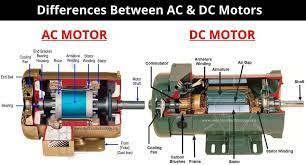In today’s world of automation and robotics, precise control of machinery is critical. The ability to control the position, velocity, and acceleration of moving parts with pinpoint accuracy is essential. This is regardless of whether it’s in manufacturing, robotics, or aerospace. This is where AC servo motors come into play. These advanced electric motors have revolutionized the way we control and automate complex mechanical systems. In this article, we will delve into what AC servo motors are, how they work, and their applications.
What is an AC Motor
An AC (alternating current) Servo Motor, is a specialized type of electric motor. It delivers precise control over speed, position, and torque in various industrial and robotic applications. AC servo motors come equipped with advanced feedback systems, enabling them to respond to changing conditions. Furthermore, these systems also allow them to follow precise commands with remarkable accuracy.
The core principle behind the AC servo motor’s function is its ability to convert electrical energy into mechanical motion efficiently. Typically, these motors are brushless, which means they lack the wear-prone brushes found in traditional brushed motors. This design choice not only enhances their durability but also reduces maintenance requirements. AC servo motors are available in various sizes and power ratings. Therefore they can accommodate a wide range of applications, from small-scale robotics to heavy-duty industrial machinery.
The hallmark feature of AC servo motors is their integration of feedback devices, such as encoders or resolvers. These sensors continuously monitor the motor’s position and speed, feeding real-time data back to a dedicated controller or servo drive. The controller processes this information and calculates the necessary adjustments required to maintain desired position, speed, or torque. This closed-loop control system enables AC servo motors to achieve an unparalleled level of precision. This makes them ideal for applications that demand accurate and repeatable motion control.

How Do AC Motors Work?
At its core, an AC servo motor is a standard electric motor that converts electrical energy into mechanical motion. These motors are typically brushless (less friction). This results in more reliability and a longer lifespan compared to brushed motors.
AC motors come equipped with feedback devices, such as encoders or resolvers. These devices constantly monitor the motor’s position, speed, and direction. This real-time feedback is crucial for precise control. A dedicated controller or servo drive processes the feedback data and sends appropriate signals to the motor. It calculates the necessary adjustments to achieve the desired position or speed. The controller’s output signal is then amplified by a power amplifier, which provides the necessary power to drive the motor. The motor is connected to a load, which can be any mechanical component that needs to be moved or controlled. A feedback loop ensures that the motor accurately moves the load to the desired position.
Industry Use of AC Motors
An example of a primary application of AC motors in industrial automation is in conveyor systems. These motors power conveyor belts and rollers. This allows for better facilitating smoother movement of raw materials, components, and finished products within manufacturing facilities. AC motors offer precise speed control, that allow manufacturers to optimize production.
Another use for AC motors is in robotics. They allow for robotic functions such as pick-and-place, welding, assembly, and material handling. The ability to control motor speed and torque with precision enables industrial robots to perform intricate and repetitive tasks with accuracy and efficiency. This not only enhances production rates but also improves product quality and consistency. AC servo motors, in particular, are favored for their rapid response times and the ability to achieve high levels of positional accuracy, making them a critical component in advanced robotic systems.
Another crucial application of AC motors in industrial automation is in CNC (Computer Numerical Control) machinery. These motors drive machine tools like lathes, milling machines, and routers, enabling manufacturers to create precise and complex components with tight tolerances. AC motors provide the necessary power and control to execute intricate machining operations, resulting in high-quality parts and reducing material waste. Additionally, the versatility of AC motors allows for the efficient use of various tooling options, contributing to the flexibility and productivity of CNC machines.
Conclusion
Conclusively, a common take on AC motors is that they are the unsung heroes of modern industrial automation. Their adaptability, reliability, and precision makes them invaluable to the manufacturing process. As industries evolve and seek higher levels of automation and precision, AC motors will remain essential components, driving progress and innovation in the pursuit of better and more efficient manufacturing and industrial processes.
Updated on December 7, 2023 by Joe Kaminski